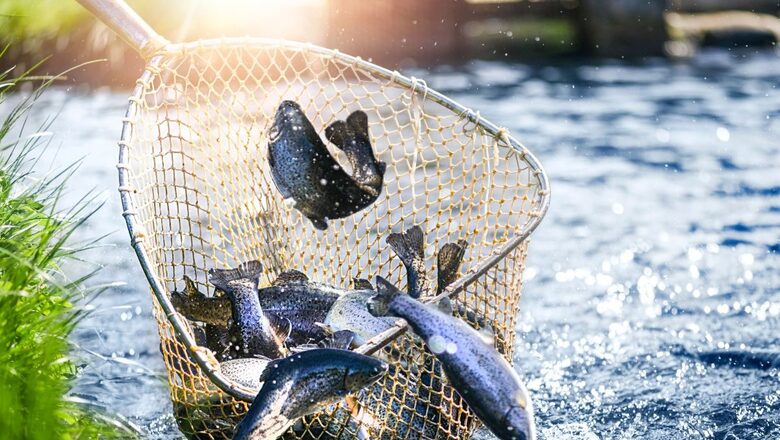
views
India’s fisheries sector has shown tremendous growth in the past decade, with a significant scale-up in inland fish production, export and aquaculture.
Inland fisheries make up for more than 70 per cent of the fish production with cumulative efforts from Centre, States/UTs and beneficiaries in all fields, says Union Minister of Fishing, Animal Husbandry and Dairying Parshottam Rupala.
To highlight India’s achievements, the Narendra Modi government is organising the Global Fisheries Conference India 2023 on November 21 and 22 at the Gujarat Science City in Ahmedabad. The event will coincide with World Fisheries Day.
The expo themed ‘Celebrate the Fisheries and Aquaculture Wealth’ will see participation by foreign missions, experts, government officials, think-tanks, academia, international organisations, industry associations and other key stakeholders. No less than 5,000 people are expected to attend the event. The conference will see the government highlighting its achievements in the fisheries sector over the past nine years.
With an 8 per cent share in global fish production, India is the 3rd largest fish producer, 2nd largest aquaculture producer, largest shrimp producer and 4th largest seafood exporter in the world. Despite having 8,000 kilometres of seashores, a vast Exclusive Economic Zone, several rivers and reservoirs, India could not tap into its strengths for the better part of its independent history.
Successive governments paid little attention to strengthening the fisheries sector. In fact, right from Independence up to 2014, just about Rs 4,000 crore was invested in India’s fisheries sector — a paltry sum that inhibited the sector’s growth.
In stark contrast, Rs 38,500 crore has been invested in the sector by the Modi government since 2014, turning it into a sunrise sector with tremendous potential. Also, in the past nine years, inland fish production has more than doubled to 131 lakh tonnes. In terms of growth, the fisheries sector has expanded since 2014 at an average rate of 8.6 per cent.
The fisheries sector provides livelihood and employment to more than 30 million (3 crore) fishers and fish farmers at just the primary level. The number of people associated with the sector indirectly is much higher. All this, while the sector itself contributes just a little over 1 per cent to India’s GDP.
The cumulative fish production since 2014 is way ahead of the fish production of the previous 30 years. In terms of shrimp production, the story gets even more remarkable. Shrimp production has increased by 267 per cent from 3.22 lakh tonnes in 2013-14 to 11.84 lakh tonnes in 2022-23. India’s sea food exports have also doubled from Rs 30,213 crore in 2013-14 to Rs 63,969 crore in 2022-23.
Work in earnest towards the upliftment of India’s fisheries sector started soon after Prime Minister Narendra Modi took over the reins of power. In 2015, the Centre, through the Blue Revolution Scheme infused Rs 5,000 crore into the sector, followed by the rollout of the Fisheries and Aquaculture Infrastructure Development Fund (FIDF), with investment target of Rs 7,522 crore. In 2019, a new ministry for Fisheries, Animal Husbandry and Dairying was created.
However, it was the Pradhan Mantri Matsya Sampada Yojana (PMMSY), launched in September 2020, that paved the way for the biggest-ever investment in the fisheries sector.
A sum of Rs 20,500 crore was allocated to address critical gaps in the fisheries value chain from fish production, productivity and quality to technology, post-harvest infrastructure and marketing. PMMSY has played a crucial role in popularising the use of technology in the fisheries sector and motivating more people to join it. For example, women in Kashmir are now rearing cold water rainbow trout using a recirculatory aquaculture system, while in Andhra Pradesh’s Nellore, entrepreneurs are exporting biofloc cultivated shrimps.
PMMSY has also paved the way for fisheries to venture in non-traditional areas. In Haryana and Rajasthan, for instance, farmers are successfully converting their saline waste lands into wealth lands through aquaculture. In terms of infrastructure development, the Modi government has approved the construction and modernisation of more than 107 fishing harbours and fish landing centres. Simultaneously, the modernisation of major fishing harbours at Cochin, Chennai, Mumbai, Vishakhapatnam and Paradeep is being undertaken.
What to Watch Out for
Just this year, India’s fisheries sector has taken significant strides, backed by the Centre’s goal of making the sector play a larger role in the economy. In February, Goa Chief Minister Pramod Sawant had said that the state will develop four fishing villages under a central government-funded scheme with the state government providing all the infrastructure.
Then, in May, the Modi government took the decision to provide 3.5 lakh free transponders to fishermen to help track their positions as well as promote their business interests. These transponders will not only allow the monitoring agencies to know the location of fishing boats all the time when they are at sea but also allow them to contact agencies from the sea. These would also allow the agencies to send warnings to fishermen about cyclones or other weather conditions.
The fishermen would, on their part, be able to contact people in distress situations and can be provided help at sea. This decision has been taken keeping in mind the accidents caused by inclement weather at sea, which adversely impacts fishermen. Another issue is that of Pakistan unilaterally detaining Indian fishermen from sea.
In Uttar Pradesh, meanwhile, Chandauli district is getting ready to house the largest fish market in Asia, the construction of which will be completed by July next year. About 1,500 people are expected to gain employment from the upcoming fish market and around 75,000 metric tonnes of fish will be traded annually if the fish market is operated at full capacity.
The past nine years have seen the fisheries sector being infused with a new energy. What was once an ignored sector despite its vast potential in India is today getting the attention it deserves. In the times to come, India’s fisheries sector has the potential to go from being a mere sunrise sector to playing a crucial role in the country’s GDP share. The next natural step for India should be to dominate the global fisheries production and supply lines.



















Comments
0 comment